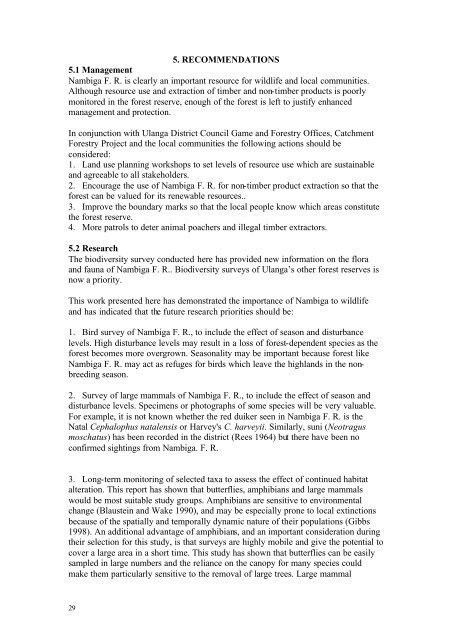Frontier Tanzania Savanna Research Programme
Frontier Tanzania Savanna Research Programme
Frontier Tanzania Savanna Research Programme
Create successful ePaper yourself
Turn your PDF publications into a flip-book with our unique Google optimized e-Paper software.
5. RECOMMENDATIONS5.1 ManagementNambiga F. R. is clearly an important resource for wildlife and local communities.Although resource use and extraction of timber and non-timber products is poorlymonitored in the forest reserve, enough of the forest is left to justify enhancedmanagement and protection.In conjunction with Ulanga District Council Game and Forestry Offices, CatchmentForestry Project and the local communities the following actions should beconsidered:1. Land use planning workshops to set levels of resource use which are sustainableand agreeable to all stakeholders.2. Encourage the use of Nambiga F. R. for non-timber product extraction so that theforest can be valued for its renewable resources..3. Improve the boundary marks so that the local people know which areas constitutethe forest reserve.4. More patrols to deter animal poachers and illegal timber extractors.5.2 <strong>Research</strong>The biodiversity survey conducted here has provided new information on the floraand fauna of Nambiga F. R.. Biodiversity surveys of Ulanga’s other forest reserves isnow a priority.This work presented here has demonstrated the importance of Nambiga to wildlifeand has indicated that the future research priorities should be:1. Bird survey of Nambiga F. R., to include the effect of season and disturbancelevels. High disturbance levels may result in a loss of forest-dependent species as theforest becomes more overgrown. Seasonality may be important because forest likeNambiga F. R. may act as refuges for birds which leave the highlands in the nonbreedingseason.2. Survey of large mammals of Nambiga F. R., to include the effect of season anddisturbance levels. Specimens or photographs of some species will be very valuable.For example, it is not known whether the red duiker seen in Nambiga F. R. is theNatal Cephalophus natalensis or Harvey's C. harveyii. Similarly, suni (Neotragusmoschatus) has been recorded in the district (Rees 1964) but there have been noconfirmed sightings from Nambiga. F. R.3. Long-term monitoring of selected taxa to assess the effect of continued habitatalteration. This report has shown that butterflies, amphibians and large mammalswould be most suitable study groups. Amphibians are sensitive to environmentalchange (Blaustein and Wake 1990), and may be especially prone to local extinctionsbecause of the spatially and temporally dynamic nature of their populations (Gibbs1998). An additional advantage of amphibians, and an important consideration duringtheir selection for this study, is that surveys are highly mobile and give the potential tocover a large area in a short time. This study has shown that butterflies can be easilysampled in large numbers and the reliance on the canopy for many species couldmake them particularly sensitive to the removal of large trees. Large mammal29
















